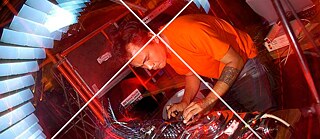Philippines
Children of Cathode Ray
Children of Cathode Ray was established in 1989 and regarded as one of the earliest experimental sound art groups in the Philippines. Its original members were: Tad Ermitano on video, visuals, bass, synthesizers, electronics, efx, computers; Jing Garcia (a.k.a. autoceremony) on audio, synthesizers, electronics, efx, computers; Blums Borres on lead guitars, efx, graphics, computers; Peter Marquez on lighting effects, electronics, photos, and visuals; Regiben Romana on percussions, efx; Magyar Tuazon on visual effects, bass, electronics. Three of the original core members (Tad, Magyar & Jing) are performing at WSK Festival of the Recently Possible.
As pioneers, Children of Cathode Ray was a collaborative attempt of a group of six enterprising bohemians hanging-out at Red Rocks (later Club Dredd) in Timog Avenue. Bred from a variety of musical and artistic genres, they got together to create unstructured music out of found instruments, new media and various electronic sound sources, including (ambient) noise. It was a meaningful attempt to deconstruct musical theories and compositions that many of us are already familiar with.
A Cathode Ray piece might have radios and 4-second cassette-tape loops feeding into a mix filled with drums and electronic percussion, effected guitars, synthesized pads, vintage gears and passionate raving in an invented language, which would in turn be augmented visually by video feedback, projections of exposed Super-8 abraded with a variety of kitchen implements, or VHS spliced on a pair of consumer VCRs.
As pioneers, Children of Cathode Ray was a collaborative attempt of a group of six enterprising bohemians hanging-out at Red Rocks (later Club Dredd) in Timog Avenue. Bred from a variety of musical and artistic genres, they got together to create unstructured music out of found instruments, new media and various electronic sound sources, including (ambient) noise. It was a meaningful attempt to deconstruct musical theories and compositions that many of us are already familiar with.
A Cathode Ray piece might have radios and 4-second cassette-tape loops feeding into a mix filled with drums and electronic percussion, effected guitars, synthesized pads, vintage gears and passionate raving in an invented language, which would in turn be augmented visually by video feedback, projections of exposed Super-8 abraded with a variety of kitchen implements, or VHS spliced on a pair of consumer VCRs.
